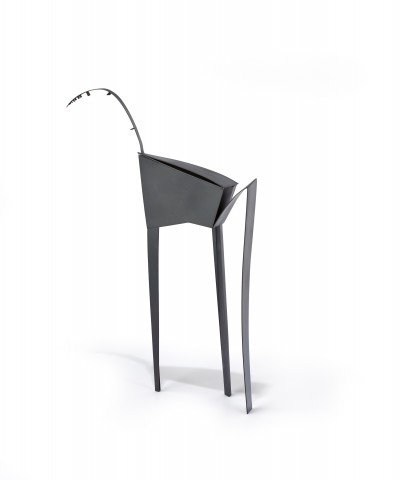LIDDED CONTAINER, 1993
MARI FUNAKI
heat blackened mild steel
30.5 x 21.5 x 5.0 cm
Craft Victoria, Melbourne
Private collection, Melbourne, acquired from the above in 1994
Reflection: Mari Funaki, Craft Victoria, Melbourne, 1994 (illus. in exhibition catalogue)
Although only practising for a relatively short period, Mari Funaki left an indelible impact on Australia's art world. Graduating from RMIT's gold and silversmithing degree in 1993, she quickly established herself as a unique and important figure through her studio practice and eponymous gallery. She created a cohesive oeuvre of jewellery and objects that are ‘formidable in their complexity and vital charge’.1
Early work encompassed small steel boxes, sculptural candle holders and jewellery, with Mari's first solo exhibition of 'containers for candles' at Melbourne's famous Kuni's restaurant in 1991 (where she also worked as a waitress). This early focus on vessels as a preferred form gave way in the late 1990s to jewellery, winning her the prestigious Herbert Hofmann Prize in Munich in 1996, and again in 1999. Mari returned to container-objects in the mid-2000s, with the final five years of her life seeing her most ambitious and celebrated works take shape.
Lidded Container, 1993 is a key early work and a clear forerunner to her later, more major sculptural works. One of the highlights from Mari's first solo exhibition in a gallery, ‘Reflection’, 1994 held at Craft Victoria, it is instantly recognisable for its dynamic, expressive tension and its crisp articulation of form – her visual language here inspired, like much of her early work prior, by insects and plants. It is also one of the first pieces to use heat-blackened mild steel, a feature in all her non-jewellery objects after 2000 which she preferred for its thinness, strength and matte blackness.
Mari Funaki explained her fascination with containers in 2005: ‘Packaging is one of the most recognisable characteristics in Japanese culture. The box is not just to contain something, but to present something, to treat it with respect and add an air of anticipation. This sense of presentation is the way in which I see my container.’2
1. Devery, J., Mari Funaki: Objects, National Gallery of Victoria, Melbourne, 2010, p. 2
2. Mari Funaki, written statement for Object Gallery, 2005.
KATIE SCOTT, DIRECTOR, GALLERY FUNAKI, MELBOURNE
